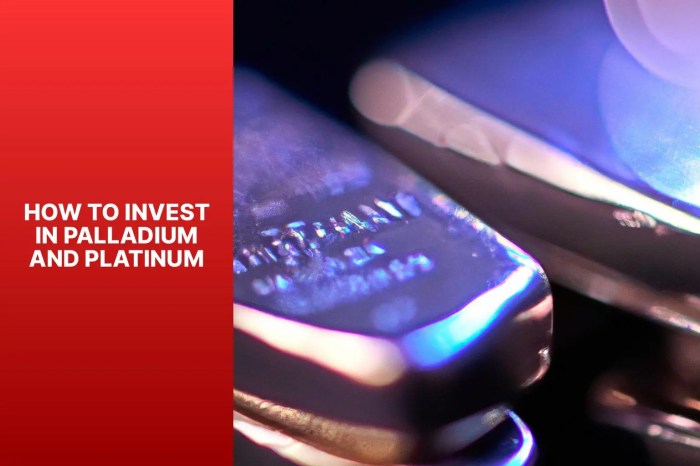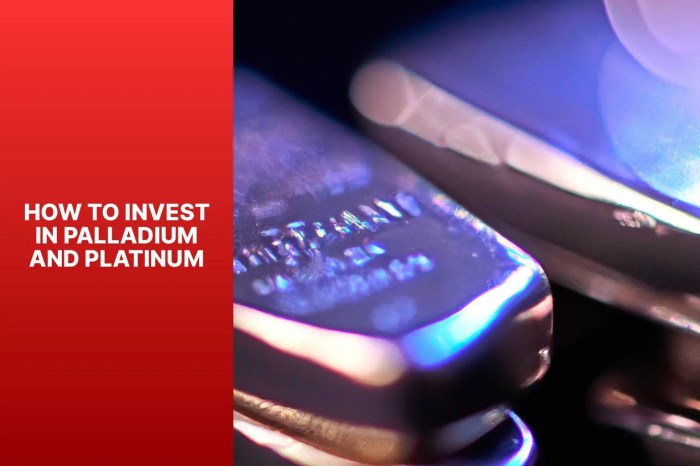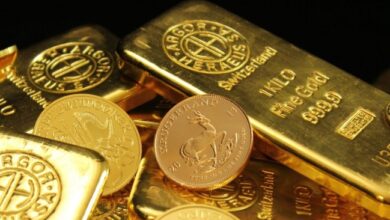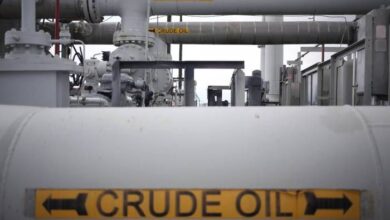
Investing in Platinum and Palladium: Exploring Untapped Opportunities
Investing in platinum and palladium exploring untapped opportunities in precious metals is a captivating journey into the world of rare and valuable resources. These metals, known for their unique properties and diverse applications, are increasingly gaining attention as potential investment avenues.
Beyond their traditional uses in jewelry and industry, platinum and palladium are finding new roles in emerging technologies, creating exciting possibilities for investors seeking to diversify their portfolios and capitalize on growth opportunities.
The demand for these metals is driven by factors like the burgeoning automotive industry, which relies heavily on platinum and palladium for catalytic converters, and the expanding renewable energy sector, which utilizes them in fuel cells and other clean energy technologies.
The global economic landscape, geopolitical events, and technological advancements all play a significant role in shaping the market dynamics of platinum and palladium, making them intriguing assets for investors seeking to navigate the complexities of the precious metals market.
Introduction to Platinum and Palladium
Platinum and palladium are two precious metals that have gained significant attention in recent years due to their unique properties and increasing demand. These metals, often grouped with gold and silver, possess distinct characteristics that make them valuable across various industries.
Properties and Uses
The value of platinum and palladium stems from their unique properties, which make them suitable for a wide range of applications. Platinum, known for its high melting point, resistance to corrosion, and catalytic properties, finds use in jewelry, automotive catalysts, and industrial applications.
Palladium, another highly corrosion-resistant metal, is prized for its ability to absorb hydrogen and is widely used in electronics, dentistry, and automotive catalysts.
Historical Use
The use of platinum and palladium dates back centuries. Platinum, discovered in South America in the 18th century, was initially used for jewelry and coinage. Palladium, discovered in 1803, found early applications in dentistry and scientific instruments. The industrial use of these metals gained momentum in the 20th century, particularly in the automotive industry, where they are essential components of catalytic converters.
Supply and Demand Dynamics
The supply and demand dynamics of platinum and palladium differ significantly from those of gold and silver. While gold and silver are primarily considered safe-haven assets, platinum and palladium have a greater industrial demand. The supply of platinum and palladium is concentrated in a few countries, primarily South Africa and Russia, making them more susceptible to geopolitical events.
Comparison with Gold and Silver
Platinum and palladium are often compared to gold and silver, but they have distinct characteristics. Gold and silver are primarily used as investment assets and have a more established market. Platinum and palladium, on the other hand, have a greater industrial demand and are more sensitive to economic fluctuations.
The demand for platinum and palladium is driven by industrial applications, while the demand for gold and silver is driven by investment and safe-haven considerations.
Current Market Trends and Drivers
The platinum and palladium markets have experienced significant fluctuations in recent years, driven by a complex interplay of factors. Understanding these trends and drivers is crucial for investors seeking to capitalize on potential opportunities within the precious metals space.
Current Market Trends and Prices
Platinum and palladium prices have exhibited distinct patterns in recent years. Palladium prices have surged dramatically, reaching record highs in 2022, primarily due to robust demand from the automotive sector, particularly for gasoline-powered vehicles. Conversely, platinum prices have been more volatile, experiencing periods of decline and recovery.
This divergence reflects the differing demand dynamics and supply constraints affecting each metal.
Diversifying your portfolio with precious metals like platinum and palladium can be a smart move, especially considering their industrial applications and potential for growth. But before diving into any investment, it’s crucial to manage your finances responsibly. A solid understanding of credit debt management tips and strategies can help you free up capital for investment and ensure you’re not putting your financial future at risk.
With a clear financial plan, you can confidently explore the exciting opportunities in the platinum and palladium markets.
Factors Driving Demand for Platinum and Palladium
- Automotive Industry:Platinum and palladium are critical components in catalytic converters, which are essential for reducing harmful emissions from gasoline and diesel engines. The increasing global demand for automobiles, particularly in emerging markets, has significantly boosted demand for these metals. Palladium, in particular, has seen strong demand as it is used in gasoline-powered vehicles, while platinum is used in diesel engines.
- Jewelry Sector:Platinum and palladium are highly valued in the jewelry industry due to their durability, rarity, and unique aesthetics. While platinum is traditionally favored for its white color and hypoallergenic properties, palladium has gained popularity as a more affordable alternative.
- Industrial Applications:Platinum and palladium have diverse industrial applications, including electronics, chemical processing, and glass manufacturing. The growth of these industries, coupled with the metals’ unique properties, contributes to their overall demand.
Impact of Geopolitical Events and Global Economic Conditions
Geopolitical events and global economic conditions can significantly impact platinum and palladium prices. For example, the Russia-Ukraine conflict has disrupted supply chains for palladium, which is primarily mined in Russia. Additionally, economic downturns can reduce demand for automobiles, affecting platinum and palladium prices.
While platinum and palladium are often overshadowed by gold and silver, they offer exciting opportunities for savvy investors seeking diversification. Their industrial applications, from automotive catalysts to electronics, make them less susceptible to the whims of fashion and more tied to global economic growth.
It’s a similar story in the world of sports, where the Indian Premier League (IPL) has become a financial juggernaut, as detailed in this fascinating blog post. Like platinum and palladium, the IPL has carved a unique niche for itself, attracting massive viewership and lucrative sponsorships.
So, if you’re looking for a safe haven in a volatile market, consider exploring the potential of precious metals, just as the IPL has done in the world of cricket.
Untapped Opportunities in Platinum and Palladium
While platinum and palladium have long been associated with traditional uses in jewelry and automotive catalysts, their applications are expanding rapidly into new and exciting sectors. These precious metals are increasingly sought after for their unique properties, particularly their catalytic, electrical, and chemical resistance capabilities, making them ideal for a wide range of emerging technologies.
Renewable Energy
The transition to renewable energy sources presents significant opportunities for platinum and palladium. Both metals are essential components in fuel cells, which convert chemical energy into electricity with high efficiency and zero emissions. Platinum, in particular, plays a crucial role as a catalyst in proton exchange membrane (PEM) fuel cells, a technology gaining traction in the automotive and stationary power generation industries.
- Hydrogen Fuel Cells:Platinum acts as the catalyst in the key reaction of hydrogen oxidation in PEM fuel cells, enabling the efficient production of electricity. The demand for platinum in this application is expected to grow significantly as the adoption of hydrogen fuel cell vehicles increases.
- Solar Energy:Platinum is used in solar cells, primarily in thin-film solar technology, where it enhances efficiency by improving charge transfer and reducing energy losses.
Electronics
The miniaturization of electronic devices and the increasing demand for high-performance computing are driving the use of platinum and palladium in electronics.
- Microelectronics:Platinum is used in microelectronics for its high electrical conductivity, corrosion resistance, and stability at high temperatures. It is employed in applications like integrated circuits, sensors, and conductive inks.
- Data Storage:Palladium is used in hard disk drives as a thin-film coating on the read/write heads, enabling faster and more reliable data storage.
Healthcare
The unique properties of platinum and palladium make them valuable in healthcare applications.
- Medical Devices:Platinum is widely used in medical implants and devices, including pacemakers, stents, and surgical instruments, due to its biocompatibility and resistance to corrosion.
- Drug Delivery:Palladium nanoparticles are being investigated for their potential in drug delivery systems, as they can be engineered to target specific cells and tissues, improving drug efficacy and reducing side effects.
Niche Markets
Beyond these broad sectors, platinum and palladium offer unique advantages in niche markets, presenting potential for significant growth.
- Jewelry:While traditional jewelry is a major consumer of platinum and palladium, new designs and trends are emerging, incorporating these metals in unique and innovative ways, such as in sustainable and ethically sourced jewelry.
- Glass Manufacturing:Palladium is used as a catalyst in the production of high-quality glass, including specialty glass for optical and aerospace applications.
- Environmental Remediation:Platinum and palladium are used as catalysts in various environmental remediation technologies, including exhaust gas treatment, water purification, and soil remediation.
Investment Strategies, Investing in platinum and palladium exploring untapped opportunities in precious metals
Investors seeking to capitalize on the untapped opportunities in platinum and palladium can consider various strategies:
- Direct Investment:Investing directly in platinum and palladium through exchange-traded funds (ETFs) or physical bullion provides exposure to the price fluctuations of these metals.
- Investing in Companies:Investing in companies involved in the mining, refining, or processing of platinum and palladium offers a way to participate in the value chain of these metals.
- Sector-Specific Funds:Investing in sector-specific funds focused on renewable energy, electronics, or healthcare provides exposure to companies utilizing platinum and palladium in their operations.
Investment Considerations and Risks: Investing In Platinum And Palladium Exploring Untapped Opportunities In Precious Metals
Investing in platinum and palladium, like any other asset class, involves considerations and risks that potential investors must carefully evaluate before making any investment decisions. Understanding the historical performance, price drivers, and potential risks associated with these precious metals is crucial for making informed investment choices.
Historical Performance of Platinum and Palladium Investments
Examining the historical performance of platinum and palladium investments provides valuable insights into their potential returns and volatility. Both metals have exhibited periods of significant price appreciation and decline, influenced by various factors, including industrial demand, supply dynamics, and economic conditions.
- Platinum: Platinum prices have historically shown a long-term upward trend, but with periods of substantial volatility. For example, platinum prices surged in the early 2000s due to strong demand from the automotive industry. However, the global financial crisis of 2008 led to a sharp decline in prices.
While exploring untapped opportunities in precious metals, it’s essential to consider the global economic landscape. The rise of Asian markets, particularly China, presents a fascinating dynamic. Apple’s success in China, as highlighted in this article , underscores the potential for growth in the region.
This growth could fuel demand for platinum and palladium, used in electronics and automotive industries, presenting an exciting opportunity for investors seeking exposure to these metals.
Since then, platinum prices have been influenced by factors such as supply disruptions in South Africa, the demand from the jewelry sector, and the increasing adoption of electric vehicles.
- Palladium: Palladium prices have experienced even greater volatility than platinum, driven by its use in catalytic converters for gasoline-powered vehicles. The rising demand for palladium from the automotive industry, particularly in China and the United States, has led to significant price increases in recent years.
However, concerns about the long-term growth of the automotive industry and the potential for alternative technologies could impact palladium prices in the future.
Factors Influencing Volatility in Platinum and Palladium Prices
The prices of platinum and palladium are subject to a wide range of factors, leading to significant price fluctuations. Understanding these factors is essential for investors to assess the potential risks and opportunities associated with these metals.
- Industrial Demand: Platinum and palladium are primarily used in industrial applications, particularly in the automotive, jewelry, and electronics sectors. Changes in demand from these industries can significantly impact prices. For example, the shift towards electric vehicles could reduce demand for platinum and palladium in the automotive sector.
- Supply Dynamics: The supply of platinum and palladium is concentrated in a few countries, primarily South Africa and Russia. Production disruptions, labor strikes, or geopolitical tensions in these regions can lead to supply shortages and price increases.
- Economic Conditions: Global economic growth and the strength of major currencies can influence the demand for platinum and palladium. During periods of economic uncertainty or recession, demand for these metals may decline, leading to lower prices.
- Investment Demand: Investment demand for platinum and palladium can also impact prices. When investors perceive these metals as safe haven assets during times of economic instability, demand can increase, driving prices higher.
Potential Risks Associated with Investing in Platinum and Palladium
While platinum and palladium offer potential investment opportunities, it is crucial to acknowledge the associated risks. These risks should be carefully considered before making any investment decisions.
- Price Volatility: Platinum and palladium prices are known for their volatility, which can result in significant losses for investors. The factors discussed earlier, such as industrial demand, supply dynamics, and economic conditions, can lead to sudden and unexpected price swings.
- Supply and Demand Imbalances: Disruptions to supply or changes in demand can create imbalances that affect prices. For example, a decline in the automotive industry or the development of alternative technologies could lead to a decrease in demand for platinum and palladium, potentially causing price declines.
- Geopolitical Risks: Platinum and palladium production is concentrated in a few countries, making them susceptible to geopolitical risks. Conflicts, political instability, or sanctions can disrupt production and affect prices.
- Storage Costs: Storing physical platinum and palladium can incur significant costs, including insurance, security, and transportation. Investors should consider these costs when evaluating the overall investment return.
Investing in Platinum and Palladium
Investing in platinum and palladium offers a unique opportunity to diversify your portfolio and potentially gain exposure to the growing demand for these precious metals. While they are often grouped with gold and silver, platinum and palladium have distinct characteristics and uses that make them attractive investment options.
Investment Options for Platinum and Palladium
There are several ways to invest in platinum and palladium, each with its own advantages and disadvantages. Here are some popular options:
- Exchange-Traded Funds (ETFs): ETFs are a convenient way to invest in platinum and palladium through a diversified portfolio of holdings. They trade on stock exchanges like regular stocks, offering flexibility and liquidity. Some popular platinum and palladium ETFs include the SPDR® Platinum Shares (PPLT) and the Aberdeen Standard Physical Palladium Shares ETF (PALL).
- Physical Bullion: Purchasing physical platinum and palladium in the form of bars, coins, or other bullion products is a direct way to own these metals. Physical bullion can be stored in a safe place or with a reputable custodian for security.
- Mining Stocks: Investing in mining stocks allows you to participate in the production and supply of platinum and palladium. However, this option comes with higher risk due to the cyclical nature of the mining industry and the potential for fluctuations in metal prices.
Advantages and Disadvantages of Investment Options
- ETFs: ETFs offer diversification, liquidity, and low costs. However, they do not provide direct ownership of the physical metal and may be subject to tracking errors.
- Physical Bullion: Physical bullion offers direct ownership and potential for price appreciation. However, it can be expensive to store and insure, and it may be difficult to sell quickly.
- Mining Stocks: Mining stocks can offer leverage to price movements in platinum and palladium, but they carry significant risk due to factors such as operational costs, regulatory changes, and environmental concerns.
Factors to Consider When Choosing an Investment Strategy
- Investment Goals: Determine your investment goals, such as capital appreciation, income generation, or diversification. This will help you choose an investment strategy that aligns with your objectives.
- Risk Tolerance: Assess your risk tolerance and choose an investment strategy that matches your comfort level with potential losses. ETFs are generally considered less risky than mining stocks.
- Time Horizon: Consider your investment time horizon. If you are investing for the long term, you may be more comfortable with the volatility of mining stocks. Short-term investors may prefer ETFs or physical bullion.
- Market Conditions: Keep an eye on current market conditions, including supply and demand, economic growth, and geopolitical events. These factors can influence the price of platinum and palladium.
Conclusion

The exploration of platinum and palladium as investment opportunities reveals a dynamic landscape with potential for both growth and risk. While these precious metals exhibit distinct characteristics and applications, they share a common thread: their value is tied to industrial demand, technological advancements, and geopolitical factors.
Key Takeaways
- Platinum and palladium are essential components in various industries, including automotive, jewelry, and electronics. This industrial demand drives their prices, making them attractive investments.
- The shift towards electric vehicles and renewable energy presents both opportunities and challenges for platinum and palladium. While the demand for platinum in fuel cells is expected to rise, the decline in traditional gasoline vehicles could impact palladium’s future.
- Geopolitical instability, supply chain disruptions, and environmental regulations can significantly influence the price of platinum and palladium. Investors should be aware of these factors and their potential impact on their investments.






